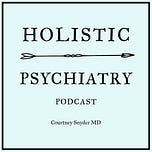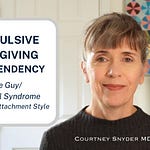“Addiction” - a compulsive, chronic, physiological, or psychological need for a habit-forming substance, behavior, or activity having harmful physical, psychological, or social effects and typically causing well-defined symptoms (such as anxiety, irritability, tremors, or nausea) upon withdrawal or abstinence.”
Like other health conditions, addiction is multifactorial. It is the result of an alignment of root causes. In this newsletter, I’ll discuss:
Substance addiction and behavioral addictions
Why addiction is not simply about dopamine and why there are multiple addictive personalities
How & why we differ in our physiologic response to substances
Our culture’s shaming and punishment of addiction while fueling addiction
The role of attachment disruption, trauma, emotional dysregulation, and social isolation
Substance Addiction
When it comes to addiction, you might expect me to talk a lot about dopamine. Not all substance addictions are the same, however. Opioids act very differently on the body than alcohol, which acts differently than cocaine. Some substances are more addictive than others, and even more so in certain people. For most people, marijuana is less addictive, while alcohol, cocaine, and opioids are more addictive.
Addictive Substances:
Alcohol
Caffeine
Cannabis
Hallucinogens
Sedatives and Hypnotics/Anxiolytics
Inhalants
Opioids
Stimulants
Tobacco
Seemingly, 10-20 % of people who try substances will have problems with addiction. Our genetic makeup and the expression of our genes will impact how we react to substances, just as they will affect how we metabolize specific medications or environmental toxins. We could, for example, have a weak enzyme that slows our metabolism of alcohol and results in our becoming more intoxicated more quickly.
We may have high neurotransmitter activity that we’re trying to calm down with substances, or we may have low neurotransmitter activity and are taking substances or even carrying out certain behaviors that increase our neurotransmitter activity.
Behavioral Addiction
While we can become severely addicted to substances, we can also become addicted to behaviors or the feelings brought on by the behavior or anticipation of the behavior.
Examples of Behavioral Addiction:
Food addiction
Sex addiction
Love and relationship addiction
Codependence is considered a relationship addiction in that relationships are often one-sided, emotionally destructive, or even abusive.
Exercise addiction
Body dysmorphic disorder
Health addiction
Shopping addiction
Gambling addiction
Work addiction
Video game addiction
Internet addiction
Smartphone addiction
Social media addiction
Porn addiction
News addiction
Information addiction
Self-harm addiction
Extremism is also felt to overlap with addiction
We can become addicted to anything that spikes the reward chemicals in our brains. If we’re not sure if we’re addicted, we can ask ourselves, “Is the compulsive behavior having negative consequences?”
The severity of our addictions falls on a spectrum. I may not have a gambling addiction where I am putting myself at financial risk; however, I could be addicted to sugar, which I know negatively impacts my health, gives me brain fog and fatigue, and causes me to check out of my relationships, including my relationship with myself.
Culture: Shame & Punishment
The last thing that we need if we are addicted to a substance or behavior is shame and punishment. Our culture still tends to see addiction as a moral failing or even a sin that can be removed with punishment. This thinking leads to simplistic consequences such as rejection by family and friends and even imprisonment. The same happens with other forms of mental illness, but in this case, there is even less understanding, less compassion, more anger, and more disdain.
Culture: Fueling Addiction
Meanwhile, most of us are becoming more addicted - addicted to our cell phones, social media, divisive stimulating news and information. We have more information coming at us than we can process. Our brains are flooded with catecholamines as we stay in highly stimulated states. One of those catecholamines is dopamine, which will drive motivation and have us in pursuit of “more.” While there may be a type of pleasure in that pursuit, it’s not a joyful or even content type of pleasure.
When we are in pursuit, we are not present in our lives. Many of us can barely process our moments, days, and lives in these modern times. For many, what was a life of memorable moments (positive and painful) has become a blur of days quickly passing by. Before we’ve had time to process what has happened, what we’ve experienced, or what we’ve felt, our minds are in pursuit of the next thing we need to know or have.
With addictive technology comes the marketing and its messages - “more food, more sex, more youth and beauty, more health, more money, more success, and even more love - the elusive movie kind. We are forgetting how to be satisfied and tolerate uncomfortable feelings.
Attachment & Trauma
We haven’t all had the same early attachment experiences. Some of us have experienced childhood trauma. We don’t know what safety feels like. Two-thirds of those with opioid addiction have childhood trauma. This doesn’t account for the trauma that can occur before verbal memory, which is usually not reported.
Childhood trauma impacts our autonomic nervous system, our limbic system, and our hormonal stress response. Before we even experience a stressor, our baseline neurotransmitters may already be too high. Our trauma, in combination with our genetic variants, may result in high neurotransmitters that we may try to calm down with our addiction, or our trauma, in combination with our genetic variants, may have us seeking out stimulation so we can feel more alive and connected.
Social Isolation
Part of our understanding of addiction comes from the work of American psychologist Dr. Bruce Alexander, who did the “Rat Park” study. Previous research had already shown that when rats were put in solitary confinement and given a choice between water and heroin or cocaine, the rats repetitively consumed the drug-laced water until they overdosed and died.
Alexander realized that the problem may not be the rats but the environment. Rats are social animals, just as we are. So, he created “rat parks,” where the rats could roam, play, socialize, and have sex. Despite being given the same access to the two types of drug-laced water, these rats preferred the plain water. Even if they did drink the drug-laced water occasionally, they never did obsessively, nor did they overdose. The social environment was protective against addiction. If we want to help those with addiction, we need to think about connection. If we want to help ourselves with an addiction, we need to think about connection.
Emotional Regulation
Our ability to regulate our emotions (increase calm and decrease fear and anger) comes through interactions with other humans - safe humans.
Ideally, we learn to regulate our emotions during our first three years. When we were distressed as infants and toddlers, we communicated that distress through our cries and facial expressions, our caregivers responded, and our physiology returned to a sense of calm and safety. This repeated process - not necessarily perfect, but “good enough” - resulted in our internalizing that early relationship and, with that, an ability to recognize our feelings, trust others, feel worthy, respond to uncomfortable feelings with coping skills, and return to our baseline emotional state. Without this skill we acquire through attachment, we can become overwhelmed by our feelings or detached from our feelings. Our experiences, genetics, and temperament will impact which direction we go.
There is not one “addictive personality” but many addictive personalities. Some of us will be highly sensitive, and others will have a low level of sensitivity. Some of us will become overwhelmed by stress or stimulation and use addictions as a way to try to calm our emotional and high neurotransmitter states. Others will seek sensory stimulation or risk-taking to bump those neurotransmitters and increase the feeling state.
Of course, our biochemical differences impact this as well:
For those of us who are undermethylated, we may find that we are sensory seeking, have high activity at the NMDA receptor, and find ourselves craving whatever has come to have meaning or has left a mark on our neurophysiology.
For those of us who are overmethylated, we may have the desire to calm things down, slow our racing thoughts, and lower our high neurotransmitter activity.
For those of us with high pyrroles (and or CAPs profile), we may feel socially anxious or overstimulated and desire to feel calm and comfortable, but at other times, we may feel brave and invincible.
“Being bold and adventurous and being sad and cautious seem like opposite personality types. However, these two paths to addiction are actually not mutually exclusive. The third way involves having both kinds of traits, where people alternatively fear and desire novelty and behavior swings from being impulsive and rash to being compulsive, fear driven, and stuck in rigid patterns. ……My own story spirals around this paradoxical situation: I was driven enough to excel academically and fundamentally scared of change and of other people—yet I was also reckless enough to sell cocaine and shoot heroin.”
- Maia Szalavitz
We need to think more broadly about addiction, just as we would any other health condition. We need to address the underlying physiological root causes, meet our human need for connection, and learn ways to experience, tolerate, and cope with our very human and necessary feeling states.
In this week’s paid newsletter, I look forward to discussing cases to illustrate how various neurotransmitters can be at play with different substance addictions and how targeted nutrients can be used in the treatment of addictions - both substance and behavioral.
Until next time,











